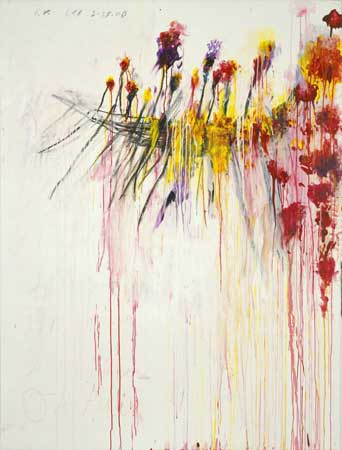His scattered dreams
Scribbles and smears, hearts and hieroglyphs – what are Cy Twombly’s paintings trying to tell us? Adrian Searle traces the evolution of a great American artist at the Tate’s new show
In pictures: Twombly at Tate Modern
Tuesday June 17, 2008
The Guardian

Ferragosto III, 1960, by Cy Twombly.
A pencil skitters over the prepared white canvas, which in places has been sloppily covered with a matt, chalky house paint. The pencil runs into a wet patch and ploughs through. When it is all dry, the pencil has another go at it. Just as images arise, they are subsumed. The line draws the layers together, and slices them apart. Everything is anxious in Cy Twombly’s early paintings, always being made and unmade. Their resolution is always provisional.
 This is a painter who talks about Poussin, about the poetry of Rainer Maria Rilke and Mallarmé. But also about De Sade and Alain Robbe-Grillet, writers whose subtlety and delicacy underline their violences.
This is a painter who talks about Poussin, about the poetry of Rainer Maria Rilke and Mallarmé. But also about De Sade and Alain Robbe-Grillet, writers whose subtlety and delicacy underline their violences.
Your eyes get lost in all this, among the love hearts, the nipples and cocks and pea-pods that might be vaginas, the jagged seismic judders, the tremors that have gone off the dial. “APOLLO,” one painting announces, and “I have known the NAKEDNESS of my scattered dreams” another. Words and phrases in Twombly’s art grin through, indelibly: names and exhortations, snatches of poetry, numbers, diagrams, all of them written with a convincing urgency. It is as though their author were swatting away a swarm of bees gathered in his brain. The words are always with us, however much some may think art is a sort of wordless communication.
In the 1950s, Twombly’s paintings evolved as a language of contrary touches, stray thoughts and inimitable gestures. There was atavism there, as well as consummate knowingness, the result of a conscious de-skilling of his innate talents. Like Willem de Kooning, Twombly forced himself to draw and write with his left hand, or with his eyes closed. (De Kooning drew while averting his eyes from the paper, and while watching TV.) Making his own touch unfamiliar, Twombly presented himself as other to himself. I think he wanted to catch himself off guard.
 Twombly is now 80, and his nervous, supremely elegant and often very beautiful art is not as well known as it might be. Cycles and Seasons, Tate Modern’s retrospective, is likely to change that. It is not the first major Twombly show to be held in Britain, but it is the largest and most thorough. It begins brilliantly, with work completed when Twombly was the student of Robert Motherwell and the educator, draughtsman and painter Ben Shahn.
Twombly is now 80, and his nervous, supremely elegant and often very beautiful art is not as well known as it might be. Cycles and Seasons, Tate Modern’s retrospective, is likely to change that. It is not the first major Twombly show to be held in Britain, but it is the largest and most thorough. It begins brilliantly, with work completed when Twombly was the student of Robert Motherwell and the educator, draughtsman and painter Ben Shahn.
Of the same generation as Jasper Johns and Robert Rauschenberg, Twombly luckily escaped the fate of being a second-generation abstract expressionist. His art belongs mostly to itself, while retaining passing affinities to many different and contrary directions in art since 1945. An American who married well and moved to Rome at the beginning of his career, Twombly suffered the mistrust of his US contemporaries for many years, but this left him largely free to pursue his art as he wanted.
